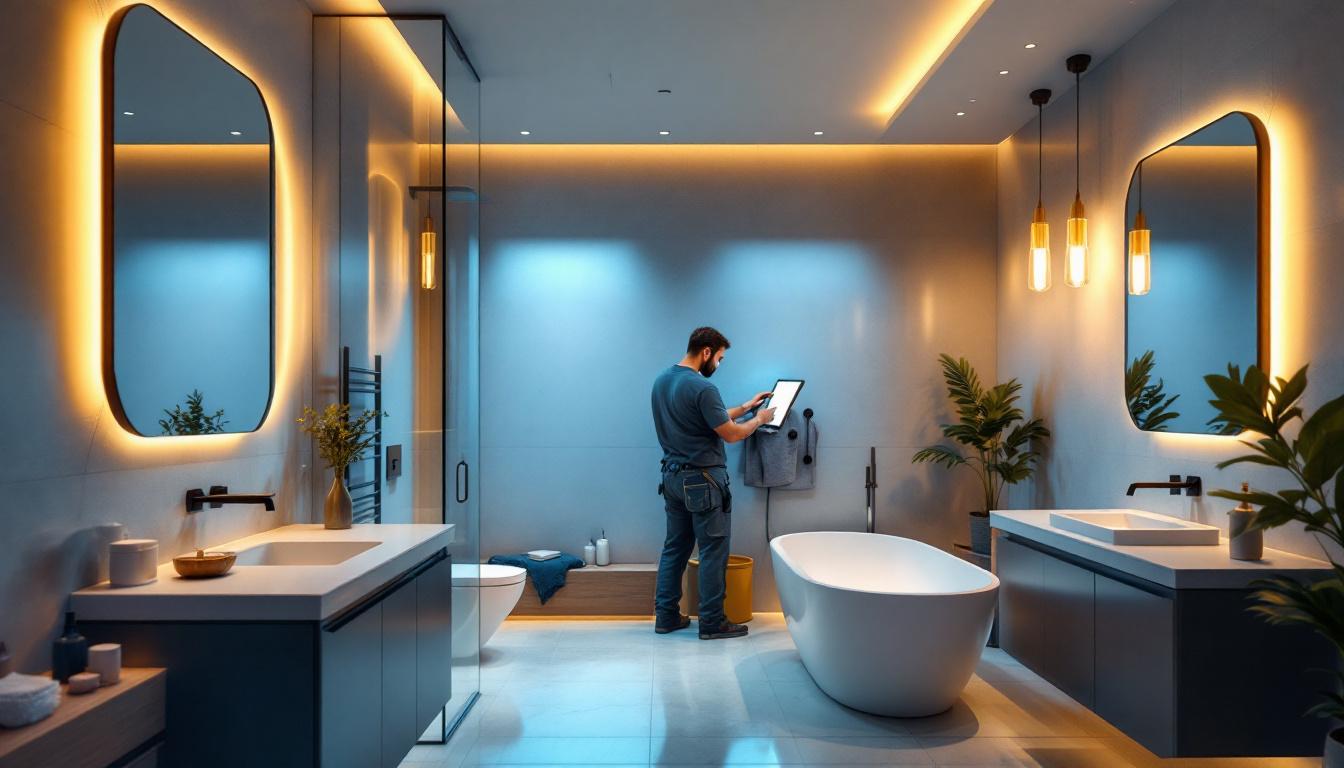
In the world of lighting installation and maintenance, contractors face a myriad of challenges that can impact their projects and client satisfaction. From technical difficulties to regulatory compliance, the potential for issues is ever-present. However, by understanding common pitfalls and implementing effective strategies, lighting contractors can navigate these challenges successfully. This article explores the key areas where problems may arise and offers practical solutions to help contractors avoid issues in their work.
Lighting contractors often encounter a range of challenges that can complicate their projects. These challenges can stem from various sources, including design flaws, equipment failures, and client expectations. Recognizing these issues early on is crucial for preventing delays and ensuring a successful outcome.
One of the primary sources of issues in lighting projects is design flaws. Poorly conceived lighting plans can lead to inadequate illumination, uneven lighting distribution, or even aesthetic mismatches with the surrounding environment. Miscommunication between contractors, designers, and clients can exacerbate these problems, resulting in costly revisions.
To mitigate these risks, it is essential for lighting contractors to establish clear communication channels from the outset. Regular meetings with clients and designers can help clarify expectations and ensure that everyone is on the same page. Additionally, utilizing advanced design software can aid in visualizing the final product, allowing for adjustments before installation begins. This proactive approach not only fosters collaboration but also empowers clients to engage more deeply in the design process, leading to a final product that aligns closely with their vision.
Moreover, incorporating feedback loops during the design phase can be invaluable. By soliciting input from all stakeholders, contractors can identify potential issues early and make necessary adjustments. This collaborative effort can also enhance client satisfaction, as they feel their opinions are valued and integrated into the project. Ultimately, a well-communicated design process can transform potential pitfalls into opportunities for innovation and creativity.
Another significant challenge faced by lighting contractors is equipment failure. Whether due to manufacturing defects or improper handling, faulty equipment can lead to project delays and increased costs. Furthermore, the reliance on specific brands or models can create vulnerabilities if those products become unavailable.
To combat this issue, contractors should maintain a diverse inventory of lighting products and be familiar with multiple brands. Regular training on equipment handling and maintenance can also minimize the risk of failures. Establishing strong relationships with suppliers can ensure access to reliable products and timely replacements when necessary. Additionally, implementing a rigorous quality assurance process can help catch potential issues before they escalate into larger problems.
Furthermore, staying abreast of industry advancements is crucial. The lighting industry is rapidly evolving, with new technologies and products emerging regularly. By investing in ongoing education and training, contractors can better understand the latest innovations, which can enhance the reliability and efficiency of their projects. This not only helps in selecting the best equipment but also positions contractors as knowledgeable leaders in the field, capable of delivering cutting-edge solutions to their clients.
Compliance with local regulations and safety standards is paramount in the lighting industry. Failure to adhere to these requirements can result in fines, project delays, and reputational damage. Understanding the specific codes and regulations that apply to each project is essential for lighting contractors.
Regulations surrounding electrical installations and lighting can vary significantly from one location to another. Lighting contractors must stay informed about local codes, including those related to energy efficiency, installation practices, and safety measures. This knowledge not only protects the contractor but also ensures the safety of the end-users.
Engaging with local trade associations or attending industry seminars can provide valuable insights into regulatory changes. Additionally, subscribing to industry publications can help contractors stay updated on best practices and compliance requirements.
Safety should always be a top priority on any job site. Lighting contractors must implement rigorous safety protocols to protect their team and clients. This includes proper training on equipment usage, adherence to safety gear requirements, and regular safety audits.
Creating a culture of safety within the team can significantly reduce the likelihood of accidents. Encouraging open discussions about safety concerns and providing ongoing training can empower workers to prioritize safety in their daily tasks.
Client expectations can often be a source of tension in lighting projects. Misunderstandings regarding timelines, budgets, and design outcomes can lead to dissatisfaction and strained relationships. Effective management of these expectations is crucial for maintaining positive client interactions.
At the beginning of any project, it is vital to clearly outline the scope of work. This includes detailing the timeline, budget, and specific deliverables. Providing clients with a comprehensive project plan can help set realistic expectations and minimize misunderstandings.
Regular updates throughout the project can also keep clients informed and engaged. By sharing progress reports and addressing any concerns promptly, contractors can foster trust and confidence in their abilities.
Changes to the project scope are often inevitable, whether due to client requests or unforeseen circumstances. Establishing a clear process for handling changes can help mitigate potential conflicts. This process should include guidelines for how changes will be communicated, assessed, and implemented.
By being transparent about the implications of changes on timelines and budgets, contractors can help clients make informed decisions. This approach not only enhances client satisfaction but also protects the contractor’s interests.
In an increasingly digital world, technology plays a crucial role in enhancing the efficiency of lighting projects. From design software to project management tools, leveraging technology can help contractors avoid common issues and improve overall project outcomes.
Advanced design and visualization tools can significantly improve the planning phase of lighting projects. These tools allow contractors to create detailed lighting layouts, simulate lighting effects, and visualize how different fixtures will interact within a space. By providing clients with realistic renderings, contractors can better communicate their vision and make necessary adjustments before installation.
Moreover, these tools can help identify potential design flaws early on, reducing the likelihood of costly changes during the installation phase. Investing in high-quality design software can lead to more successful project outcomes and higher client satisfaction.
Project management software can streamline various aspects of lighting projects, from scheduling to budgeting. These platforms enable contractors to track progress, manage resources, and communicate with team members and clients more effectively.
By utilizing project management tools, contractors can minimize the risk of delays and keep projects on track. Features such as task assignments, deadline reminders, and budget tracking can enhance overall efficiency and ensure that all team members are aligned with project goals.
Strong relationships with suppliers and subcontractors can greatly influence the success of lighting projects. Reliable partnerships can lead to better pricing, timely deliveries, and access to quality materials. Conversely, weak relationships can result in delays and increased costs.
Lighting contractors should prioritize building strong relationships with their suppliers and subcontractors. This can be achieved through regular communication, timely payments, and a commitment to mutual success. By fostering a collaborative environment, contractors can ensure that they receive the support they need to complete projects efficiently.
Additionally, engaging with multiple suppliers can provide contractors with options and flexibility. This diversity can be particularly beneficial in times of supply chain disruptions, allowing contractors to pivot quickly and maintain project timelines.
Conducting regular performance reviews of suppliers and subcontractors can help identify areas for improvement and strengthen partnerships. By discussing successes and challenges openly, contractors can work collaboratively to enhance overall performance.
These reviews can also serve as an opportunity to align expectations and address any concerns. By maintaining open lines of communication, contractors can ensure that all parties are working towards the same goals.
The lighting industry is constantly evolving, with new technologies, techniques, and regulations emerging regularly. To stay competitive, lighting contractors must prioritize continuous learning and professional development.
Investing in training and certification programs can enhance the skills and knowledge of lighting contractors and their teams. These programs can cover a range of topics, from technical skills to project management and customer service.
By staying up-to-date with industry trends and best practices, contractors can improve their service offerings and increase client satisfaction. Additionally, certifications can enhance a contractor’s credibility and attract new clients.
Engaging with industry associations and attending networking events can provide valuable opportunities for learning and collaboration. These interactions can lead to new partnerships, insights into emerging trends, and access to resources that can enhance a contractor’s business.
Participating in workshops, seminars, and trade shows can also expose contractors to innovative products and techniques, allowing them to stay ahead of the competition.
Lighting contractors face numerous challenges in their work, but by understanding common issues and implementing effective strategies, they can avoid potential pitfalls. From clear communication and regulatory compliance to leveraging technology and building strong relationships, there are many ways to enhance project outcomes and client satisfaction.
By prioritizing continuous learning and professional development, contractors can stay competitive in a rapidly evolving industry. Ultimately, a proactive approach to addressing challenges will not only benefit contractors but also lead to successful projects and satisfied clients.
Ready to elevate your lighting projects and avoid the common pitfalls discussed? Choose LumenWholesale for your lighting needs. We provide contractors with top-quality, spec-grade lighting products at unbeatable wholesale prices. With our direct approach, you’ll enjoy superior lighting without the inflated markups often found with local distributors. Our extensive selection not only meets but exceeds industry standards, ensuring reliable, high-performance lighting for every project. Plus, with free shipping on bulk orders, you get the premium lighting you need at the best value — no hidden fees, no compromises. Make the smart choice for quality, affordability, and convenience. Visit LumenWholesale today and experience Wholesale Lighting at the Best Value for your next project.

Discover the essential resources lighting contractors rely on to master motion sensor flood lights.

Discover essential tips for lighting contractors to seamlessly integrate solar-powered lights with switches.

Discover the common pitfalls lighting contractors face when working with 5000K light color.

Discover the best bathroom recessed lighting options and learn how lighting contractors can boost efficiency, safety, and aesthetics—unlock expert tips today!.